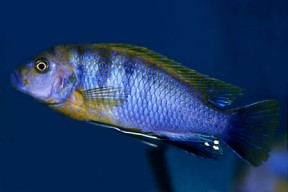Pseudotropheus fainzilberi
Goldbreast Zebra
Classification
Cichlidae
Distribution
Endemic to Lake Malawi. It occurs along a stretch of the north-eastern coast from Chirwa Island to Usisya.
Habitat
It inhabits rocky areas of the shoreline and around islands.
Maximum Standard Length
7″ (17.5cm).
Aquarium SizeTop ↑
48″ x 18″ x 15″ (120cm x 45cm x 37.5cm) – 200 litres absolute minimum due to its adult size and highly aggressive nature (see below).
Maintenance
Much of the aquarium should contain piles of rocks arranged to form caves with small areas of open water between. A sandy substrate is best. The growth of algae should not be discouraged as the fish will browse on it.
Water Conditions
Temperature: 75-82°F (24-28°C)
pH: 7.6-8.8
Hardness: 10-25°H
Diet
It will accept most foods offered but vegetable matter in the form of spirulina flakes, blanched spinach, nori etc. should form a large proportion of the diet. This can be supplemented with live and frozen varieties. Do not feed high protein foods, particularly animal meat of any kind as this has an adverse effect on the digestive tract of the fish.
Behaviour and CompatibilityTop ↑
One of the most aggressive and territorial mbuna. It should not be kept with peace loving species such as Peacocks or Utaka but it can be combined with other large mbuna, provided they do not resemble it in patterning. The tank should be overcrowded to reduce aggression and territory formation. It is incredibly aggressive towards others of the same species and the presence of heterospecifics helps to dissipate this. However, a very large tank is required in order to keep more than one male and even then, it is likely that the sub-dominant male(s) will be killed. Several females should be kept per male in order to reduce harassment.
Sexual Dimorphism
The male is usually larger and more colourful than the female. Both sexes have egg spots in the anal fin, but these are larger and more intense in the male.
Reproduction
Possible but not easy. Maternal mouthbrooder. Ideally, it should be spawned in a species tank in a harem of one male and 4-6 females. However, it will often spawn in the community aquarium. A 48″ aquarium is an adequate size (although larger is preferable) and this should be furnished as suggested above, along with some flat stones and areas of open substrate to act as potential spawning sites. Make sure plenty of hiding places are provided, as the male may kill females that are not ready to spawn. The pH should be around 8.2-8.5 and the temperature 77-80°F. The fish should be conditioned with plenty of live and frozen foods.
The male fish will clean and then display around his chosen spawning site, showing intense colour and attempting to entice females to mate with him. He is very aggressive in his pursuits and it is in order to dissipate this aggression that this species should be spawned in a harem. When a female is willing, she will approach the spawning site and lay her eggs there, after which she picks them up in her mouth. The male fish has egg-shaped spots on his anal fin and the female is attracted to these. When she tries to add them to the brood in her mouth, she actually recieves milt from the male, thus fertilising the eggs.
The female will carry the eggs for around 3-4 weeks before releasing the free swimming fry. She will not eat during this period and can be easily spotted by her distended mouth. If a female is overly stressed, she may spit out the brood prematurely or eat them. Care must be taken if you decide to move the fish in order to avoid fry predation or harassment by the males. However we do recommend that holding females are removed, as the male will usually not leave them alone. Some breeders artificially strip the fry from the mother’s mouth at the 2 week stage and raise them from that point as this usually results in a larger number of fry.
The fry are large enough to take brine shrimp nauplii from birth.
NotesTop ↑
There is ongoing debate as to the true genus of this species, it having been variously grouped in both Maylandia and Metriaclima as well as the currently valid Pseudotropheus. It is unlikely it will remain in Pseudotropheus, however. One interesting feature is the presence of additional rows of teeth when compared to others in the genus. Also, the rows of bicuspid teeth, used for rasping algae from rock surfaces, extend further back into the mouth than in other Pseudotropheus.
P. fainzilberi is not a good species for the beginner being both large and highly aggressive but makes a stunning addition to the advanced aquarist‘s collection.


